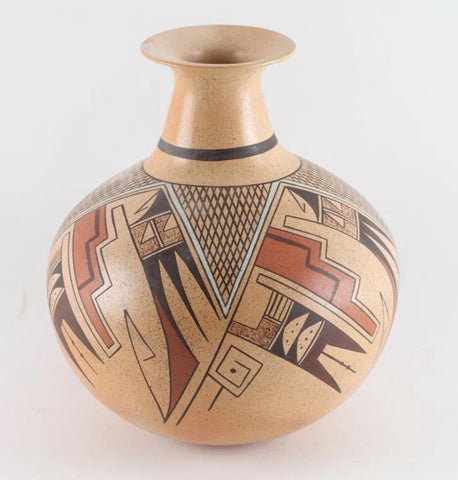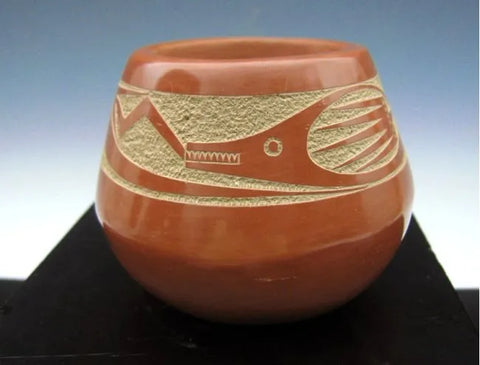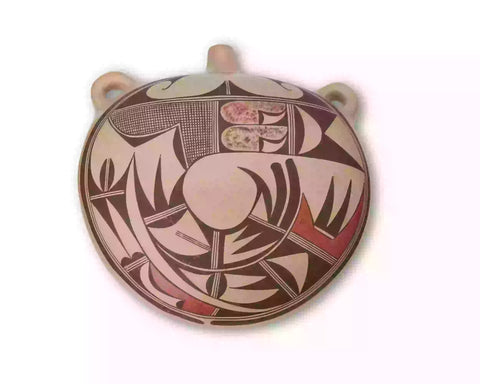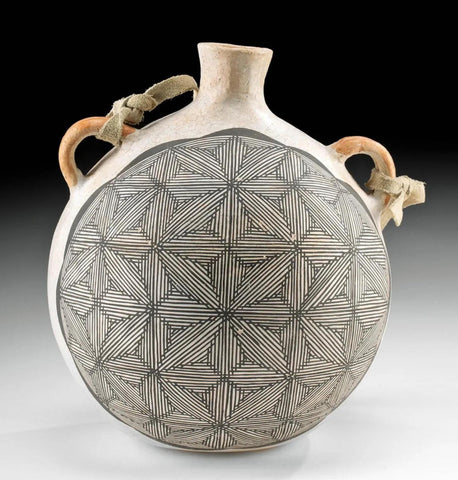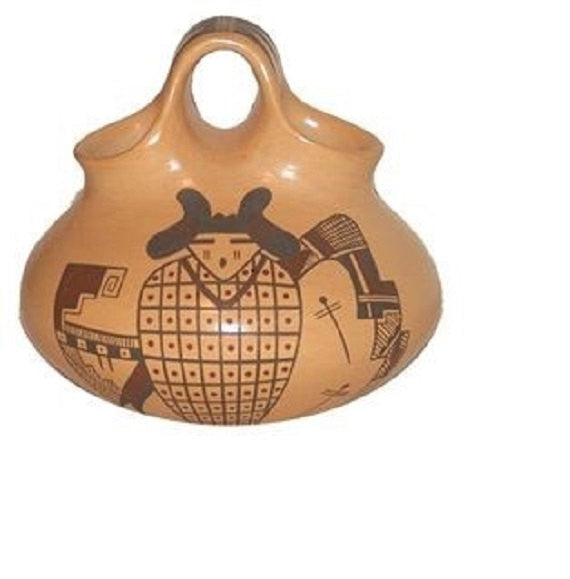
Hopi Pottery : Beautiful Hopi Pottery Jar by Agnes Nahsonhoya #76 SOLD
$ 432.00
Hopi Pottery
76. Late 1900's, Beautiful, shorter version of a double-necked wedding vase with human and avian figures. Very good condition. 4-1/2" x 4-1/2"
"Agnes Setalla Nahsonhoya, Hopi Pueblo is the daughter of Pauline Setalla and the niece of Eunice Navasie (Featherwoman). She has been an active potter for about 20 years.
The clay she uses comes from near her home. She uses no slip over the clay, but burnishes the natural clay, as it exists. She boils mustard weed for the black paint and various stones for red and white. The clay she uses produces a light peach color after firing. She paints with a yucca brush in traditional manner.
"I was born in Keams Canyon, Arizona and reared on a small ranch in Snowbird Canyon. I'm a Hopi potter and a member of the Bear Clan. My family has been working with clay for a very long time. I have always been interested in art.
"The art of pottery making was taught to me by my mother, Pauline Setalla, my aunt, Eunice Navasie, and my grandmother, Agnes Navasie. They taught me all the important steps of making clay into finished pottery. I have been making pottery for 18 years. It has always been a part of me.
"In 1992, I entered numerous pots in Northern Arizona's Hopi Show. I received my first blue ribbon for a pottery drum a rare piece.
"My style of pottery has changed through the years, starting with the white slip on natural clay, and then moving on towards the more traditional style of using no slip. I now mainly do the traditional style, it is more beautiful, and my grandmother started with traditional.
"The clay I use is found near my home. Different colors come from clay's, mustard weed for black paint which is boiled until it is like taffy, and various stones for red and white. The clay I mainly use produces a light peach or red color after firing. My coloring instruments are a matchstick end, used for a dotted effect in design and a thin yucca brush.
"To show proper respect for the clay we need to continue doing it the old way, that means digging our clay, hand-coiling, hand-burnishing, and outdoor firing. I want to continue doing pottery for as long as I live. I enjoy working with my hands and using my mind to create new and different styles. I love my work, it give me enjoyment and pleasure to work with the clay. My teachings and heritage of pottery making continues today in the creations of my children. From the hands of my mother, to the dampness of the clay, to the smell of the smoke when the pots are fired, I am connected to the clay.
"As a member of the Bear Clan, my trademark is the Bear Claw.""
Source: Provided by Tom Tallant and published in Hopi-Tewa Pottery 500 Artist Biographies by Gregory Schaaf.
A History of Pueblo Pottery:
Pueblo pottery is made using a coiled technique that came into northern Arizona and New Mexico from the south, some 1500 years ago. In the four-corners region of the US, nineteen pueblos and villages have historically produced pottery. Although each of these pueblos use similar traditional methods of coiling, shaping, finishing and firing, the pottery from each is distinctive. Various clay's gathered from each pueblo's local sources produce pottery colors that range from buff to earthy yellows, oranges, and reds, as well as black. Fired pots are sometimes left plain and other times decorated most frequently with paint and occasionally with applique. Painted designs vary from pueblo to pueblo, yet share an ancient iconography based on abstract representations of clouds, rain, feathers, birds, plants, animals and other natural world features.
Tempering materials and paints, also from natural sources, contribute further to the distinctiveness of each pueblo's pottery. Some paints are derived from plants, others from minerals. Before firing, potters in some pueblos apply a light colored slip to their pottery, which creates a bright background for painted designs or simply a lighter color plain ware vessel. Designs are painted on before firing, traditionally with a brush fashioned from yucca fiber.
Different combinations of paint color, clay color, and slips are characteristic of different pueblos. Among them are black on cream, black on buff, black on red, dark brown and dark red on white (as found in Zuni pottery), matte red on red, and poly chrome a number of natural colors on one vessel (most typically associated with Hopi). Pueblo potters also produce un-decorated polished black ware, black on black ware, and carved red and carved black wares.
Making pueblo pottery is a time-consuming effort that includes gathering and preparing the clay, building and shaping the coiled pot, gathering plants to make the colored dyes, constructing yucca brushes, and, often, making a clay slip. While some Pueblo artists fire in kilns, most still fire in the traditional way in an outside fire pit, covering their vessels with large potsherds and dried sheep dung. Pottery is left to bake for many hours, producing a high-fired result.
Today, Pueblo potters continue to honor this centuries-old tradition of hand-coiled pottery production, yet value the need for contemporary artistic expression as well. They continue to improve their style, methods and designs, often combining traditional and contemporary techniques to create striking new works of art. (Source: Museum of Northern Arizona)
----------------
View the other items in my shop: http://www.etsy.com/shop/CulturalPatina?ref=shopsection_shophome_leftnav
'

